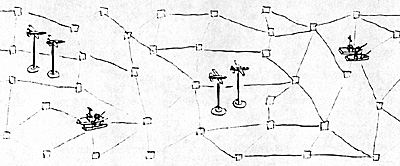As described in one of this year's earlier issues, I picked up a copy of SEA STRIKE at the HISTORICON convention. This is a two-dimensional early 1970's naval game played with cardboard counters on a flat blue surface. One of my first thoughts in looking at the presentation, was "Why not eliminate the need to measure movement distance?".
I laid out a table-size map on which I sketched a large number of nodes, or junctions, across the field. The idea was that ships would move from junction to junction... the scale of the game, therefore, was such that there was no need for the micro-inching "move 3cm, turn 10 degrees, move 3 cm, turn 10 degrees, etc." so prevalent in tactical naval wargames.
Next, having set out the map on the ping-pong table, it looked like there was a lot of 'wasted space'... and there was. The areas defined by the lines between the junctions were not being used at all... and so a wee bit more cogitation produced the configuration shown in Sketch 1.

Ships would move from junction to junction, while aircraft would move from area to area. To prevent the junctions and areas from becoming too cluttered with playing pieces, there was stacking limit of 2 tokens per junction, and 2 per area.
The map proved helpful in moving and separating two different types of units... ships and planes... and now, the question arose... what other type of game could utilize the same map format?
More cogitation... and the answer was... 15mm ancients! Here, we'd have infantry, the slower moving troops, passing from junction to junction, while the more rapidly moving cavalry could zip along from area to area.
Enter Haub the Magnificent
Enter Fred Haub. We played a couple of games, adjusting rules when necessary. The way the map was laid out, there were 7 major junctions, which we defined as major cities. In our first efforts, we'd each simply advance across the field, capturing as many cities as possible to amass victory points.
During one of our post game discussions, Fred came up with the idea that we could transform this into a "Mongol Horde" game". Here, the Emperor of China, would initially be in possession of all assets on the map, and the "Mongol Hordes" would come sweeping across the field. Problem. I examined my inventory of 15mm ancients assets... not a Chinese-person to be seen, let alone a Mongol-Horde-person. Our "Mongol Horde" game was still-borne.
But of the generic Ancients-persons, I had a slew... little men with funny beards and funny hats and bows and swords and spears... and if we termed these little fellas "Babylonians", or "Hittites", or "Philistines", or "Assyrians", or "Chaldeans"... who'd know the difference?
But now for the difficult part... game balance. The Mighty King of Babylonia, Happ Shett Sut ('Sut' to his intimates), initially owns everything in sight on the map... in fact, we gave more than everything. In addition to the major cities which were located at the junctions, we placed several small towns in the areas on the field.
Sut is fairly happy... after all, he owns everything in sight... when, suddenly, on one baseline, appears a contingent of heavy cavalry. They can't belong to Sut, since his troops only consist of heavy infantry and medium infantry. And so the game begins.
At first, we thought that perhaps we'd have the invading barbarian cavalry pop up all over the place.
This, however, placed a double-whammy on Sut. First, without a clear knowledge of where the next group of barbarians would appear, Sut couldn't advance troops toward the barbarians presently on the field. Second, he couldn't adequately amass troops toward any one area of the map, since the randomly-appearing barbarians would simply avoid his units.
In our first game under this system, we used the "pop up" technique for the invading barbarians. I took the part of Sut, sitting in the Imperial Palace. On Turn 1, Fred Haub brought on several stands of Hittites... at least, they looked like Hittites to me. But these were Hittites with a vengeance... they were all heavy cavalry.
The Hittites attacked one of my outlying cities, located in the north of my empire, and I quickly amassed a number of heavy and medium infantry and set forth to help out the besieged city.
As soon as my relieving force set out to the north, then, on the very next turn, Haub's second group of invaders appeared... this time, Assyrians, and they popped up in the south.
At this point in time, I could see that the Babylonian Empire was in deep trouble. There was no way the Mighty Sut could gather his forces to meet the invaders... if Sut's troops marched east, then Chaldean forces would appear in the west, and if Sut's troops marched south, then Phillistine forces would appear in the north.
Sut's best strategy seemed to be to remain huddled in the Imperial Palace, watching CNN record the demise of his empire.
And so, after this one experiment, we decided to use the 'sweeping horde' concept... the barbarians could appear on any of two baselines. From these lines, they'd advance across the field, destroying whatever they could. Knowing the origin of the barbarians, Sut could then adequately draw units from his backwater cities and towns, i.e., those not under attack, moving the troops forward to counter the invaders.
As far as combat/melee rules, victory point totals, revenue points, and all the other paraphernalia that comes with a campaign game... these easily fell into line, and there will be more later as Happ Shett Sut defends his empire.
Back to PW Review December 1997 Table of Contents
Back to PW Review List of Issues
Back to MagWeb Master Magazine List
© Copyright 1997 Wally Simon
This article appears in MagWeb (Magazine Web) on the Internet World Wide Web.
Other military history articles and gaming articles are available at http://www.magweb.com